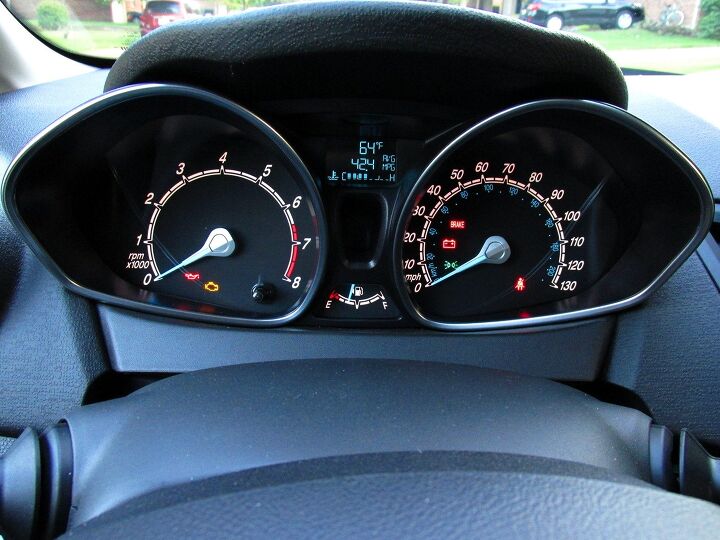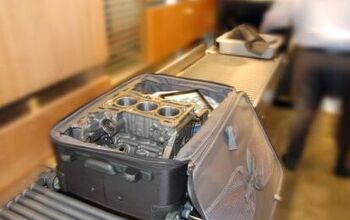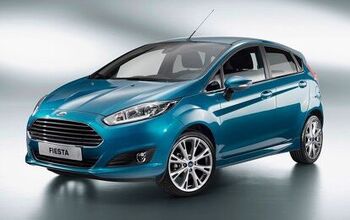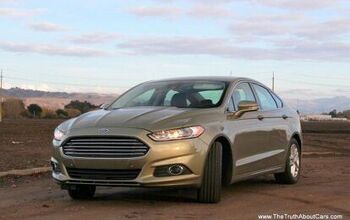Deep Dive: Ford 1.0L Ecoboost

Brown paint isn’t available from the factory and adding diesel would require pumping out its fuel system, but Ford’s Fiesta SFE is practically built for the Internet. Though sales projection for the turbocharged, direct-injected three cylinder subcompact are modest, the car is at least proving popular to discuss. TTAC has already triple-teamed the basics through capsule reviews – it is more composed than sporty, more mature than it is hoonish, and the selling proposition is a bit of a mystery. Ford sent me the car for a week’s evaluation as well. What’s left to be said?
Quite a bit actually, as long as you are interested in FoMoCo’s smallest production engine. This ain’t the paint shaker you’ve experienced in the Mitsubishi Mirage or other triples. If anything, it’s a sign of things to come.
Most North Americans associate three cylinder engines with improved fuel economy, reduced power and added vibration. In spite of this, Ford boldly suggests you spend an extra $995 to get the three cylinder over than the standard inline four. Horsepower (123) only improves by a modest three geldings over the 1.6 Sigma four, but 148 lb. ft. of torque (an improvement of 36) will get the driver’s attention. Fuel economy, at 31 city/43 highway/36 combined, is up by 3/7/5 versus the Sigma. While arranging for the loan, Ford also insisted that the 1.0L EcoBoost was a qualitative improvement too. That’s a bold claim, but 450 miles of driving convinced me that Ford pulled it off.
Vibration is inherent in three cylinder engines – an odd number of cylinders means there are no “equal but opposite” actions happening across the engine block to calm things down. Left to their own devices, triples tend to move around on their mounts and often make booming resonances. OEMs generally respond by adding counterrotating balance shafts. This minimizes vibration at the expense of fuel economy and power output, which isn’t much of a sales pitch.
Ford chose a different path. As seen in the below video, fore-and-aft motion was dealt with by intentionally unbalancing the flywheel and accessory pulley. The increased lateral motion was then handled via careful tuning of the engine mounts and their placement. They aren’t active mounts like some publications have reported, but they generally do the job. Startup is a touch rougher than a well-tuned inline four and buzz sometimes passes through the steering wheel at idle, but my passengers suspected nothing unusual ahead of the firewall. So far, so good.
An iron block allows for compact overall dimensions and cylinder walls of just 6 millimeters. The thin walls and dual cooling circuits in the engine (one for the block, one for the aluminum head) both aid warm-up times and improve efficiency. The oil pump is a variable-displacement unit and particularly improves efficiency at higher rpm. The crankshaft is also offset to reduce friction along the pistons. Some early press reports indicated that the Fiesta SFE features regenerative brakes as well. Don’t go looking for any additional batteries or electric motors – the car only features a “smart” alternator that cycles during deceleration to avoid unnecessary taxing of the engine. Start-stop isn’t offered in the US, but Ford said this was only due to market acceptance (the option is available with this engine in Europe).
Interestingly, the exhaust manifold is water-cooled and integrates directly into the cylinder head. (The upcoming 2.7L EcoBoost engine also features this construction). This water-cooling negates the need to dump extra fuel to cool the turbo at high rpm. Speaking of turbos, this specimen is of the small, low-inertia sort and spins up to 248,000 rpm. A vacuum-actuated wastegate keeps the turbo spooled when freewheeling to reduce lag. At least on paper, power and efficiency are both accounted for then.
Power and efficiency were both accounted for during my driving as well. The gearing stops it from feeling Fiesta ST-fast, but 125 lb. ft. of torque at 2,500 rpm is plenty sufficient for city maneuvers if you don’t write for Car & Driver. Interstate performance was also among the best I’ve met in a subcompact – 70 mph equates to a peaceable 2,500 rpm, yet passing power is intact. My daily drive is a 40/40/20 split of highway/country/city driving. The overall result after 450 miles was 42.8 miles per gallon (I took one final Interstate drive before snapping the above picture). Driven like I owned it, I’m sure the Fiesta would yield at least a couple more mpg.
So far, we’ve established that this is a high-feature engine that happens to be small. Does it require high-end maintenance then? Not according to Ford’s published schedule. Some competing small displacement turbocharged engines require unusual oil weights, but the 5W-20 Ford calls for should be an easy find at your local autoparts store. The side-mounted oil filter will be messy, but at least the entire underside of the engine bay isn’t totally shrouded in plastic (I’M LOOKING AT YOU, FORD ESCAPE 1.6!). The top of the engine resembles a spaghetti-monster of plumbing at first glance, but accessory belts, spark plugs and the other DIY maintenance items are all accessible. The shade tree mechanic isn’t obsolete yet then… depending how you feel about the timing belt. As with some of Ford’s other recent small engine implementations, the belt is sealed and immersed in oil to reduce friction, reduce noise and increase the service interval. An inspection is called for at 150,000 miles, but Ford expects the belt to last the life of the engine. That’s great if they are right, but the replacement will be exceptionally complex if they are wrong.
Quibbles aside, 450 miles was enough to convince me that the 1.0L EcoBoost is both a qualitative and quantitative improvement over the 1.6 Sigma. Those who consider the Fiesta too small may be more interested in the upcoming application in the Focus. Ford is currently mum on whether the Focus will be tuned for more output in North America, but these variants already exist in Europe – the 1.0L EcoBoost has achieved 160 hp with just software tweaks and 200 hp with hardware upgrades. Whether this particular engine sells in meaningful volumes in North America will probably hinge on the ability to pair the engine with an automatic transmission in the upcoming Focus, but the 1.0L Ecoboost is undoubtably a sign of the times. And I know at least 42.8 reasons why that isn’t a bad thing.

More by Daniel Latini
Latest Car Reviews
Read moreLatest Product Reviews
Read moreRecent Comments
- Redapple2 I gave up on Honda. My 09 Accord Vs my 03. The 09s- V 6 had a slight shudder when deactivating cylinders. And the 09 did not have the 03 's electro luminescent gages. And the 09 had the most uncomfortable seats. My brother bought his 3rd and last Honda CRV. Brutal seats after 25 minutes. NOW, We are forever Toyota, Lexus, Subaru people now despite HAVING ACCESS TO gm EMPLOYEE DISCOUNT. Despite having access to the gm employee discount. Man, that is a massive statement. Wow that s bad - Under no circumstances will I have that govna crap.
- Redapple2 Front tag obscured. Rear tag - clear and sharp. Huh?
- Redapple2 I can state what NOT to buy. HK. High theft. Insurance. Unrefined NVH. Rapidly degrading interiors. HK? No way !
- Luke42 Serious answer:Now that I DD an EV, buying an EV to replace my wife’s Honda Civic is in the queue. My wife likes her Honda, she likes Apple CarPlay, and she can’t stand Elon Musk - so Tesla starts the competition with two demerit-points and Honda starts the competition with one merit-point.The Honda Prologue looked like a great candidate until Honda announced that the partnership with GM was a one-off thing and that their future EVs would be designed in-house.Now I’m more inclined toward the Blazer EV, the vehicle on which the Prologue is based. The Blazer EV and the Ultium platform won’t be orphaned by GM any time soon. But then I have to convince my wife she would like it better than her Honda Civic, and that’s a heavy lift because she doesn’t have any reason to be dissatisfied with her current car (I take care of all of the ICE-hassles for her).Since my wife’s Honda Civic is holding up well, since she likes the car, and since I take care of most of the drawbacks of drawbacks of ICE ownership for her, there’s no urgency to replace this vehicle.Honestly, if a paid-off Honda Civic is my wife’s automotive hill to die on, that’s a pretty good place to be - even though I personally have to continue dealing the hassles and expenses of ICE ownership on her behalf.My plan is simply to wait-and-see what Honda does next. Maybe they’ll introduce the perfect EV for her one day, and I’ll just go buy it.
- 2ACL I have a soft spot for high-performance, shark-nosed Lancers (I considered the less-potent Ralliart during the period in which I eventually selected my first TL SH-AWD), but it's can be challenging to find a specimen that doesn't exhibit signs of abuse, and while most of the components are sufficiently universal in their function to service without manufacturer support, the SST isn't one of them. The shops that specialize in it are familiar with the failure as described by the seller and thus might be able to fix this one at a substantial savings to replacement. There's only a handful of them in the nation, however. A salvaged unit is another option, but the usual risks are magnified by similar logistical challenges to trying to save the original.I hope this is a case of the seller overvaluing the Evo market rather than still owing or having put the mods on credit. Because the best offer won't be anywhere near the current listing.




































Comments
Join the conversation
Sorry for the double post.
I was so entranced by this engine that I bought one in June, upgrading from a Honda Fit. I took it out onto the highway during the test drive to check the RPMs at highway speed -- like the reviewer -- was almost shocked at the 2500 rpms while moving faster than 70 mph. The car was also VERY quiet. The Fit, by comparison, which had 120,000 very sturdy miles, ran nearly 4,000 at the speed and I had gotten used to the noise. Also, at 75 mph, you can goose the Fiesta and it'll still move faster. The Fit was pretty stretched at that speed. There's no extra vibration or noise, the mileage is 34 in central Chicago (where the computer will show my horrible average speed at 17 or something), and can hit 50 on the highway if you drive about 55 with cruise control on. Driving 75 will lower the mileage to the mid-40s. All good. The torque is really surprising, since the motor is so small. It does get hot, but when it is hot, something keeps running for a while (and not just the fan) after you shut it off -- to cool things, I'm sure. The gearing is perfect. There are 5 speeds, spaced right for the torque. Shifting is smooth. The new Fit with 6 speeds yet has same gearing at the top. This wouldn't solve the RPM issue, and frankly I can't see why I'd have needed another gear there in the middle. Lastly, the Fit (2007) lacked MANY basic conveniences, from no map lights or glove box light to thermometer, auto door locking, certainly no computer, etc. The Fiesta, to my surprise, has EVERYTHING. I figure that since it's a major big seller in Europe, they designed its electronics as if it were a regular car, not a stripper or starter. And the SYNC system, not the flaky MYFORD TOUCH, does very nicely with voice commands to make phone calls and play any media from my phone -- from music and audiobooks to Spotify. I guess you've figured out I like this car. A lot. Though it's not as big as the Fit, I can still crowd in 3-4 teens for a quick ride somewhere. Or plenty of luggage for me and my sweetie. And even for a road trip with a few teens, though they'd have to keep the bag count low. :-)